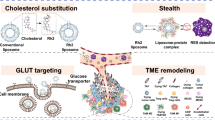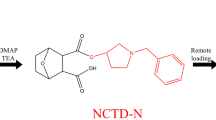Abstract
The Ginsenoside Rh2 (Rh2) has been shown to possess anti-cancer properties both in vitro and in vivo. However, the poor bioavailability and fast plasma elimination limit the further clinical applications of Rh2 for cancer treatments. In the present study, three types of Rh2-loaded liposomes including Rh2-loaded normal liposome (Rh2-LP), Rh2-loaded cationic liposome (Rh2-CLP), and Rh2-loaded Methoxy poly(ethylene glycol)-poly(lactide) (mPEG-PLA) liposome (Rh2-PLP) have been optimized and prepared with mean particle size of 80–125 nm. Compared to Rh2-LP, surface modifications with mPEG or octadecylamine significantly improve the physicochemical and biological properties both in vitro and in vivo. Moreover, PLP presented better tumor accumulation of the fluorescent cyanine dye, 1,1′-dioctadecyl-3,3,3′,3′-tetramethylindotricarbocyanine iodide (DiR) in HepG2-xenografted nude mice than CLP (1.3-fold) or LP (1.6-fold) and prolong the resident time of DiR in tumor and organs (more than 24 h). The in vivo anti-cancer efficacy assessments indicate that Rh2-PLP presents the most activity on suppressing tumor growth in HepG2-xenografted mice than Rh2-LP and Rh2-CLP and without any significant toxicity. Our results indicate that mPEG-PLA modified liposome should be a potential and promising strategy to enhance the therapeutic index for anti-cancer agents.
Graphical Abstract







Similar content being viewed by others
References
Abu-Lila A, Suzuki T, Doai Y, Ishida T, Kiwada H (2009) Oxaliplatin targeting to angiogenic vessels by PEGylated cationic liposomes suppresses the angiogenesis in a dorsal air sac mouse model. J Control Release 134:18–25
Abu-Lila AS, Ishida T, Kiwada H (2010) Targeting anticancer drugs to tumor vasculature using cationic liposomes. Pharm Res 27:1171–1183
Abu-Lila AS, Eldin NE, Ichihara M, Ishida T, Kiwada H (2012) Multiple administration of PEG-coated liposomal oxaliplatin enhances its therapeutic efficacy: a possible mechanism and the potential for clinical application. Int J Pharm 438:176–183
Allen TM, Cullis PR (2013) Liposomal drug delivery systems: from concept to clinical applications. Adv Drug Deliv Rev 65:36–48
Andresen TL, Jensen SS, Jørgensen K (2005) Advanced strategies in liposomal cancer therapy: problems and prospects of active and tumor specific drug release. Prog Lipid Res 44:68–97
Bae YH, Park K (2011) Targeted drug delivery to tumors: myths, reality and possibility. J Control Release 153:198–205
Biswas S, Dodwadkar NS, Deshpande PP, Parab S, Torchilin VP (2013) Surface functionalization of doxorubicin-loaded liposomes with octa-arginine for enhanced anticancer activity. Eur J Pharm Biopharm 84:517–525
Cai S, Yang Q, Bagby TR, Forrest ML (2011) Lymphatic drug delivery using engineered liposomes and solid lipid nanoparticles. Adv Drug Deliv Rev 63:901–908
Chen X, Wang X, Wang Y, Yang L, Hu J, Xiao W, Fu A, Cai L, Li X, Ye X, Liu Y, Wu W, Shao X, Mao Y, Wei Y, Chen L (2010) Improved tumor-targeting drug delivery and therapeutic efficacy by cationic liposome modified with truncated bFGF peptide. J Control Release 45:17–25
Cheng CC, Yang SM, Huang CY, Chen JC, Chang WM, Hsu SL (2005) Molecular mechanisms of ginsenoside Rh2-mediated G1 growth arrest and apoptosis in human lung adenocarcinoma A549 cells. Cancer Chemother Pharmacol 55:531–540
Coimbra M, Isacchi B, van Bloois L, Torano JS, Ket A, Wu X, Broere F, Metselaar JM, Rijcken CJ, Storm G, Bilia R, Schiffelers RM (2011) Improving solubility and chemical stability of natural compounds for medicinal use by incorporation into liposomes. Int J Pharm 416:433–442
Dadashzadeh S, Mirahmadi N, Babaei MH, Vali AM (2010) Peritoneal retention of liposomes: effects of lipid composition, PEG coating and liposome charge. J Control Release 148:177–186
Elmowafy M, Viitala T, Ibrahim HM, Abu-Elyazid SK, Samy A, Kassem A, Yliperttula M (2013) Silymarin loaded liposomes for hepatic targeting: in vitro evaluation and HepG2 drug uptake. Eur J Pharm Sci 50:161–171
Gref R, Domb A, Quellec P, Blunk T, Müller RH, Verbavatz JM, Langer R (1995) The controlled intravenous delivery of drugs using PEG-coated sterically stabilized nanospheres. Adv Drug Deliv Rev 16:215–223
Gu Y, Wang GJ, Sun JG, Jia YW, Wang W, Xu MJ, Lv T, Zheng YT, Sai Y (2009) Pharmacokinetic characterization of ginsenoside Rh2, an anticancer nutrient from ginseng, in rats and dogs. Food Chem Toxicol 47:2257–2268
Ishida T, Harashima H, Kiwada H (2002) Liposome clearance. Biosci Rep 22:197–224
Justo OR, Moraes AM (2005) Kanamycin incorporation in lipid vesicles prepared by ethanol injection designed for tuberculosis treatment. J Pharm Pharmacol 57:23–30
Kazakov S, Levon K (2006) Liposome-nanogel structures for future pharmaceutical applications. Curr Pharm Des 12:4713–4728
Kim HK, Davaa E, Myung CS, Park JS (2010) Enhanced siRNA delivery using cationic liposomes with new polyarginine-conjugated PEG-lipid. Int J Pharm 392:141–147
Kim CE, Lim SK, Kim JS (2012) In vivo antitumor effect of cromolyn in PEGylated liposomes for pancreatic cancer. J Control Release 157:190–195
Kolate A, Baradia D, Patil S, Vhora I, Kore G, Misra A (2014) PEG-a versatile conjugating ligand for drugs and drug delivery systems. J Control Release 192:67–81
Langner M, Kral TE (1999) Liposome-based drug delivery systems. Pol J Pharmacol 51:211–222
Li SD, Huang L (2010) Stealth nanoparticles: high density but sheddable PEG is a key for tumor targeting. J Control Release 145:178–181
Li X, Ding L, Xu Y, Wang Y, Ping Q (2009) Targeted delivery of doxorubicin using stealth liposomes modified with transferrin. Int J Pharm 373:116–123
Maeda H (2012) Macromolecular therapeutics in cancer treatment: the EPR effect and beyond. J Control Release 164:138–144
Maeda H, Sawa T, Konno T (2001) Mechanism of tumor-targeted delivery of macromolecular drugs, including the EPR effect in solid tumor and clinical overview of the prototype polymeric drug SMANCS. J Control Release 74:47–61
Maeda H, Bharate GY, Daruwalla J (2009) Polymeric drugs for efficient tumor-targeted drug delivery based on EPR-effect. Eur J Pharm Biopharm 71:409–419
Mei L, Fu L, Shi K, Zhang Q, Liu Y, Tang J, Gao H, Zhang Z, He Q (2014) Increased tumor targeted delivery using a multistage liposome system functionalized with RGD, TAT and cleavable PEG. Int J Pharm 468:26–38
Mirahmadi N, Babaei MH, Vali AM, Dadashzadeh S (2010) Effect of liposome size on peritoneal retention and organ distribution after intraperitoneal injection in mice. Int J Pharm 383:7–13
Mohammed AR, Bramwell VW, Kirby DJ, McNeil SE, Perrie Y (2010) Increased potential of a cationic liposome-based delivery system: enhancing stability and sustained immunological activity in pre-clinical development. Eur J Pharm Biopharm 76:404–412
Mu CF, Balakrishnan P, Cui FD, Yin YM, Lee YB, Choi HG, Yong CS, Chung SJ, Shim CK, Kim DD (2010) The effects of mixed MPEG–PLA/Pluronic® copolymer micelles on the bioavailability and multidrug resistance of docetaxel. Biomaterials 31:2371–2379
Naicker K, Ariatti M, Singh M (2014) PEGylated galactosylated cationic liposomes for hepatocytic gene delivery. Colloids Surf B 122:482–490
Nakamura K, Yamashita K, Itoh Y, Yoshino K, Nozawa S, Kasukawa H (2012) Comparative studies of polyethylene glycol-modified liposomes prepared using different PEG-modification methods. Biochim Biophys Acta 1818:2801–2807
Oku N, Namba Y (1994) Long-circulating liposomes. Crit Rev Ther Drug Carrier Syst 11:231–270
Paliwal SR, Paliwal R, Agrawal GP, Vyas SP (2011) Liposomal nanomedicine for breast cancer therapy. Nanomedicine 6:1085–1100
Qian T, Cai Z, Wong RN, Jiang ZH (2005) Liquid chromatography/mass spectrometric analysis of rat samples for in vivo metabolism and pharmacokinetic studies of ginsenoside Rh2. Rapid Commun Mass Spectrom 19:3549–3554
Resina S, Prevot P, Thierry AR (2009) Physico-chemical characteristics of lipoplexes influence cell uptake mechanism and transfection efficacy. PLoS One 4:6058–6069
Saengkrit N, Saesoo S, Srinuanchai W, Phunpee S, Ruktanonchai UR (2014) Influence of curcumin-loaded cationic liposome on anticancer activity for cervical cancer therapy. Colloids Surf B 114:349–356
She ZG, Liu XY, Kotamraju VR, Ruoslahti E (2014) Clot-targeted micellar formulation improves anticoagulation efficacy of bivalirudin. ACS Nano 8:10139–10149
Shehata T, Ogawara K, Higaki K, Kimura T (2008) Prolongation of residence time of liposome by surface-modification with mixture of hydrophilic polymers. Int J Pharm 359:272–279
Sun S, Wang CZ, Tong R, Li XL, Fishbein A, Wang Q, He TC, Du W, Yuan CS (2010) Effects of steaming the root of Panax notoginseng on chemical composition and anticancer activities. Food Chem 118:307–314
Szebeni J, Muggia F, Gabizon A, Barenholz Y (2011) Activation of complement by therapeutic liposomes and other lipid excipient-based therapeutic products: prediction and prevention. Adv Drug Deliv Rev 63:1020–1030
Tagami T, Suzuki T, Matsunaga M, Nakamura K, Moriyoshi N, Ishida T, Kiwada H (2012) Anti-angiogenic therapy via cationic liposome-mediated systemic siRNA delivery. Int J Pharm 422:280–289
van den Hoven JM, Nemes R, Metselaar JM, Nuijen B, Beijnen JH, Storm G, Szebeni J (2013) Complement activation by PEGylated liposomes containing prednisolone. Eur J Pharm Sci 49:265–271
Wang H, Zhao P, Liang X, Gong X, Song T, Niu R, Chang J (2010) Folate-PEG coated cationic modified chitosan–cholesterol liposomes for tumor-targeted drug delivery. Biomaterials 3:4129–4138
Wen Z, Yan Z, Hu K, Pang Z, Cheng X, Guo L, Zhang Q, Jiang X, Fang L, Lai R (2011) Odorranalectin-conjugated nanoparticles: preparation, brain delivery and pharmacodynamic study on Parkinson’s disease following intranasal administration. J Control Release 151:131–138
Yan Z, Wang F, Wen Z, Zhan C, Feng L, Liu Y, Wei X, Xie C, Lu W (2012) LyP-1-conjugated PEGylated liposomes: a carrier system for targeted therapy of lymphatic metastatic tumor. J Control Release 157:118–125
Yang T, Cui FD, Choi MK, Cho JW, Chung SJ, Shim CK, Kim DD (2007) Enhanced solubility and stability of PEGylated liposomal paclitaxel: in vitro and in vivo evaluation. Int J Pharm 338:317–326
Yang ZZ, Li JQ, Wang ZZ, Dong DW, Qi XR (2014) Tumor-targeting dual peptides-modified cationic liposomes for delivery of siRNA and docetaxel to gliomas. Biomaterials 35:5226–5239
Yoshino K, Nakamura K, Terajima Y, Kurita A, Matsuzaki T, Yamashita K, Isozaki M, Kasukawa H (2012) Comparative studies of irinotecan-loaded polyethylene glycol-modified liposomes prepared using different PEG-modification methods. Biochim Biophys Acta 1818:2901–2907
Zalba S, Navarro I, Trocóniz IF, Tros de Ilarduya C, Garrido MJ (2012) Application of different methods to formulate PEG-liposomes of oxaliplatin: evaluation vitro and in vivo. Eur J Pharm Biopharm 81:273–280
Zhang J, Zhou F, Wu X, Gu Y, Ai H, Zheng Y, Li Y, Zhang X, Hao G, Sun J, Peng Y, Wang G (2010) 20(S)-ginsenoside Rh2 noncompetitively inhibits P-glycoprotein in vitro and in vivo: a case for herb-drug interactions. Drug Metab Dispos 38:2179–2187
Zhao Y, Li J, Yu H, Wang G, Liu W (2012) Synthesis and characterization of a novel polydepsipeptide contained tri-block copolymer (mPEG-PLLA-PMMD) as self-assembly micelle delivery system for paclitaxel. Int J Pharm 430:282–291
Acknowledgments
This work was kindly supported by the Talent Summit of Six Major Industry of Jiangsu Province (7th) and Technology of the People’s Republic of China (No. 2009ZX09310-004), the New Drug Innovation Project from the Ministry of Science and Central University Basal Research Fund Project (NO. JKY2011059).
Author information
Authors and Affiliations
Corresponding author
Additional information
L. Xu and H. Yu have contributed equally to this work.
Rights and permissions
About this article
Cite this article
Xu, L., Yu, H., Yin, S. et al. Liposome-based delivery systems for ginsenoside Rh2: in vitro and in vivo comparisons. J Nanopart Res 17, 415 (2015). https://doi.org/10.1007/s11051-015-3214-z
Received:
Accepted:
Published:
DOI: https://doi.org/10.1007/s11051-015-3214-z




